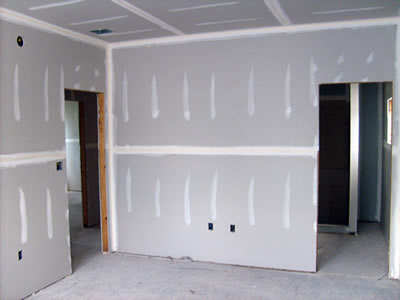 Often when people are remodeling a home, they may consider redoing the counter-tops, putting in hardwood flooring, or remodeling the cabinets. One thing people often overlook is the condition of their interior walls. The interior walls of any home need to be in pristine condition. Unfortunately, walls can be damaged and deteriorate over time. The most common and effective method to fix walls is by patching or replacing them using sheetrock. If you contact All Star Plumbing & Restoration sheetrock services, we can patch up your wall and leave it looking brand new!
Often when people are remodeling a home, they may consider redoing the counter-tops, putting in hardwood flooring, or remodeling the cabinets. One thing people often overlook is the condition of their interior walls. The interior walls of any home need to be in pristine condition. Unfortunately, walls can be damaged and deteriorate over time. The most common and effective method to fix walls is by patching or replacing them using sheetrock. If you contact All Star Plumbing & Restoration sheetrock services, we can patch up your wall and leave it looking brand new!
Sheetrock or drywall, is a panel made of gypsum plaster, pressed against two thick pieces of paper. Sheetrock can be referred to as many names: drywall, wallboard, plasterboard, or gypsum board. Sheetrock is a very durable material that can be used for ceilings, arches, walls, or any kind of interior surface! Sheetrock also adds fire resistance to your home and could prevent your home from burning own in certain circumstances! Drywall is also a very easy material to repair when damaged, contrary to the traditional plaster homes. Among other things, drywall may need to be patched from fire damages or wind damages.
Before sheetrock, the walls of homes were made using plaster. Where sheetrock only takes a couple of days to set up in a home, plaster would take a few weeks. For centuries, homes were lathered with wet plaster that would stick to the walls and ceilings and take weeks to dry. This process would take multiple layers of plaster and each layer would need to be added after the previous layer dried. This process was very labor intensive and repairing any damages would be much harder than they are now with sheetrock walls.
Thankfully, drywall was invented in the early 20th century. It was originally purposed for only small fixes, as homeowners trusted the more expensive and traditional plaster. However, once World War 2 came around, people were looking to save money and began building homes with sheetrock. Being cost effective and even cheap was considered patriotic at the time, as this meant you were letting more labor or effort go into the war rather than your home. By the 1960’s, sheetrock had become a household norm.
The primary material in sheetrock, gypsum, is found is desert like areas and looks a lot like white sand. The material actually has crystallized water in it. Though this leaves the molecules in the gypsum feeling dry, this is the reason sheetrock is fire resistant. As the drywall heats up, the water molecules in the gypsum evaporate, leaving the drywall cool, protecting the materials behind it (your home’s structure) in the process.
Installing sheetrock involves three separate, equally important steps. The first step is hanging drywall, this process includes cutting drywall to fit your wall, lifting the drywall and hanging it up against the wall’s boards, drilling it in properly to ensure stability. The next step is taping, where we use what we call ‘mud’ to lather across the drywall seams, sealing any cracks. After the first layer of mud, we apply drywall tape to the seems and then add two more layers of mud to assure the tape holds. The final step is using a pole sander to sand the mud applied earlier, this smoothes the mud and gives your wall a nice, even appearance. Painting your walls afterwords can give your home a strong presence! If you need a drywall installed, contact All Star Plumbing & Restoration sheetrock services and we can hang, tape, and texture your sheetrock so you can enjoy your home’s new look! If your wall suffers any damages, like holes in the wall, drywall repair is extremely easy to do yourself, but we recommend contacting a professional for installation!





